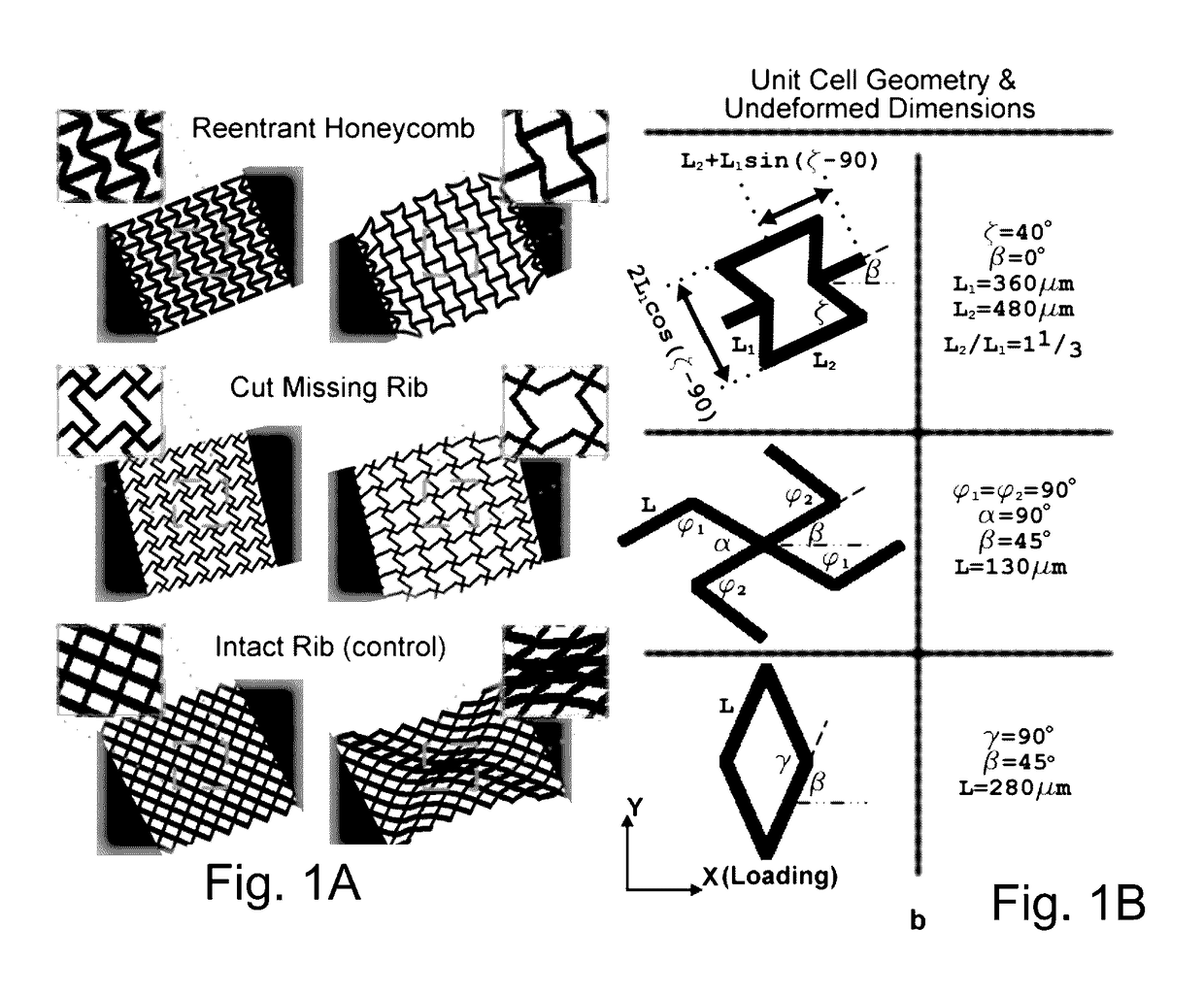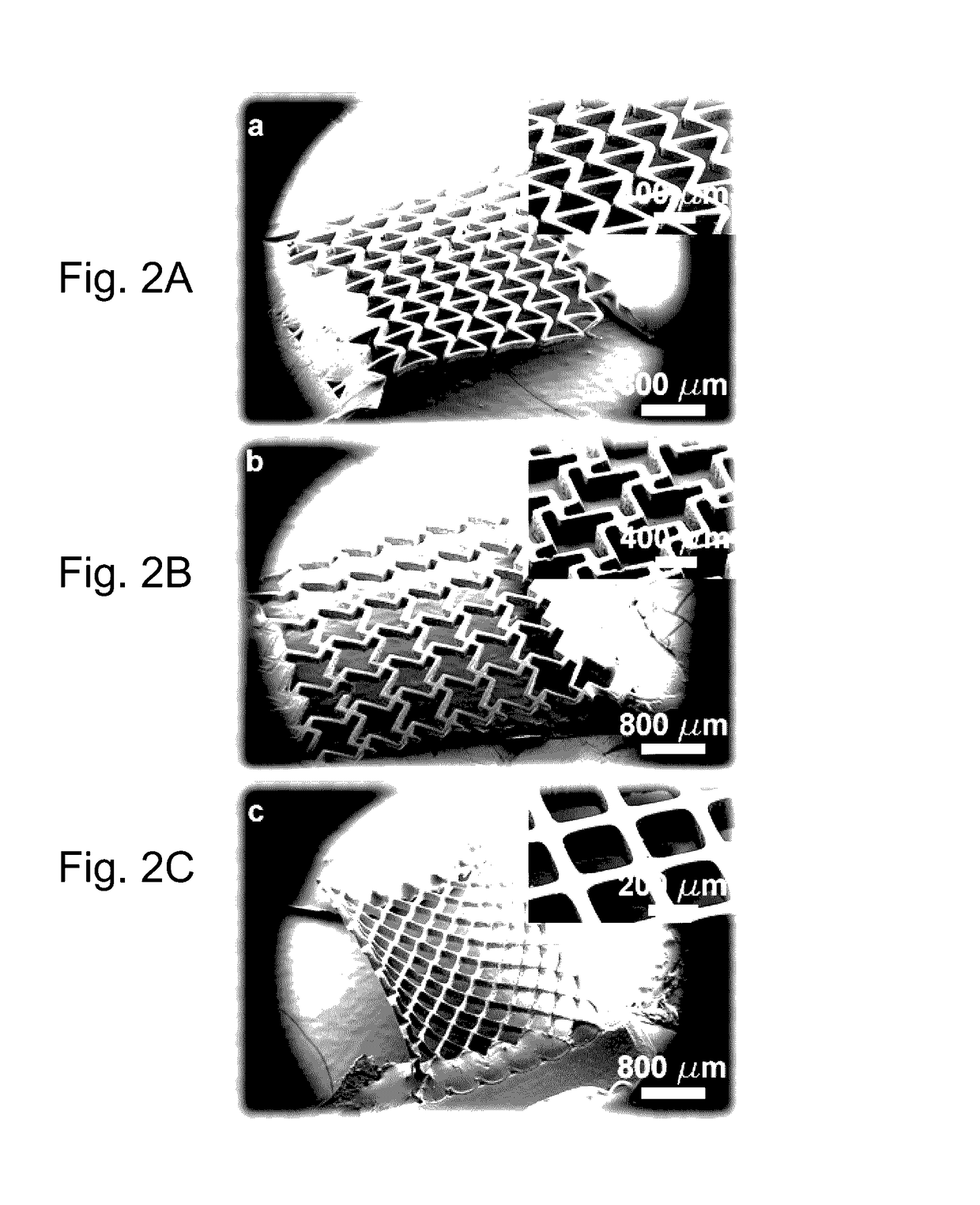Microstructure biomaterials and fabrication methods therefor
a microstructured biomaterial and fabrication method technology, applied in the field of microstructured biomaterials, can solve the problems of little practical control over the cellular microstructure, no fully characterizing the elastic behavior of the construct, and no report on the fabrication of three-dimensional biomaterial constructs exhibiting a negative poisson's ratio and other problems, to achieve the effect of accurate prediction
- Summary
- Abstract
- Description
- Claims
- Application Information
AI Technical Summary
Benefits of technology
Problems solved by technology
Method used
Image
Examples
example 1
Preparation of Photocurable Monomers
[0094]Poly(ethylene glycol)diacrylate (PEGDA, Mw=700), acrylic acid (AA), and 2,2,6,6-tetramethylpiperidine 1-oxyl (TEMPO, free-radical quencher) were obtained from Sigma-Aldrich. Photoinitiator Irgacure 2959 and TINUVIN 234 UV-dye were obtained from Ciba Chemistry. TINUVIN 234 is a UV-absorbing agent, which was used to reduce the curing depth of the monomers and adjust the thickness of the microstructures in the DMD-based layer-by-layer fabrication process. TEMPO, on the other hand, enhances the contrast of the UV-curing process and optimizes feature resolution at the projection plane. 1% (w / v) Irgacure 2959, 0.15% (w / v) of TINUVIN 234, and 0.01% (w / v) of TEMPO were added to the PEGDA monomer and mixed thoroughly.
example 2
Digital Micro-Mirror Array Device (DMD) Fabrication
[0095]FIG. 6 shows a schematic of the DMD-based system used to fabricate the auxetic biomaterial scaffolds. Two-dimensional (2D) graphics models of the scaffold layers were designed in computer-aided drafting (CAD) software (AutoCAD LT 2006; Autodesk, Inc., San Raphael, Calif., USA). CAD models in the drawing interchange format (DXF file extension, outputted from AutoCAD) were converted into standard bitmap format (BMP file extension) and exported to LabVIEW software (National Instruments, Austin, Tex., USA), which was used to control the DMD system. The bitmap graphics files were used as virtual photomasks during the DMD layer-by-layer photocuring process.
[0096]A servo-stage 60 with X, Y and Z axis motion was positioned 100 μm below a transparent quartz plate 62 (quartz microscope slide), leaving a 100 μm gap 61 between the plate and the stage. 10 μL of photocurable prepolymer was injected into the gap 61 with a syringe pump 63. Th...
example 3
Stress-Strain Finite Element Simulations
[0098]AutoCAD LT was used to design the 2D scaffold layers with the desired unit-cell structures. The unit-cell structures were designed from analytical models proposed in the literature. The 2D models were imported into SOLIDWORKS® 3D CAD software (SOLIDWORKS® 2009, Dassault Systèmes SolidWorks Corp., Concord, Mass., USA) and extruded to form 3D models of the single-layer sheets. The 3D models were utilized to simulate the elastic stress-strain (deformation) behavior of the single-layer PEG constructs using finite element analysis (also conducted with SOLIDWORKS®; FIGS. 10E and 10FA), taking into account the material properties of the PEG. The simulations allowed us to determine if the unit-cell structures would, theoretically, yield auxetic behavior as desired. The simulations were performed in the same way in which the strain experiments were conducted, i.e., where one of the rectangular side-blocks was fixed while an axial tensile stress w...
PUM
| Property | Measurement | Unit |
|---|---|---|
| width | aaaaa | aaaaa |
| width | aaaaa | aaaaa |
| Poisson's ratio | aaaaa | aaaaa |
Abstract
Description
Claims
Application Information
 Login to View More
Login to View More - R&D
- Intellectual Property
- Life Sciences
- Materials
- Tech Scout
- Unparalleled Data Quality
- Higher Quality Content
- 60% Fewer Hallucinations
Browse by: Latest US Patents, China's latest patents, Technical Efficacy Thesaurus, Application Domain, Technology Topic, Popular Technical Reports.
© 2025 PatSnap. All rights reserved.Legal|Privacy policy|Modern Slavery Act Transparency Statement|Sitemap|About US| Contact US: help@patsnap.com



